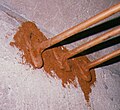Bulkhead
The bulkhead (n, plural bulkheads, more rarely bulkheads, but not bulkheads ) is a closed partition or, in the older meaning, a fastener that can be pushed forward. A bulkhead can be designed to be airtight, liquid-tight or fire-retardant (fire bulkhead) (see Maritime Fire Fighting ).
shipbuilding
In shipbuilding , a bulkhead is a continuous wall within the ship. Passages in partition walls with a lockable hatch to prevent water from entering are also called bulkheads. Collision bulkheads were compulsory on newly built merchant ships from 1929.
A continuous wall that divides the interior of a ship into watertight or gas-tight compartments is also known as a bulkhead. In modern shipbuilding, such bulkheads are used in the longitudinal and transverse direction (longitudinal bulkhead and transverse bulkhead). The bulkhead deck is at the top of the watertight compartments that are created in this way . The installation of bulkheads in a hull is intended to limit flooding to leaked areas in order to maintain buoyancy. In the event of an accident , they should maintain the function of the vehicle until the damaged area can be secured. Other tasks are the subdivision and structural reinforcement of the hull .
The Chinese were the first to use the bulkhead construction, such a hull from the 12th / 13th centuries. The 16th century is preserved on the Quanzhou ship , and bulkheads were also used in the construction of Admiral Zheng He's deep-sea fleet in the 15th century. Outside of China, ships in bulkhead construction were not built until around 1836. The most famous early ships of this type include the wheel frigate Guadeloupe ( keel laid in 1836) and the passenger ship Great Eastern (maiden voyage 1858).
A collision bulkhead is used to contain water ingress when the ship collides with another ship or an obstacle. This bulkhead extends from the baseline to the deck at the level of one of the front frames . The collision bulkhead separates the bow of the ship from the rest. The separated space serves to dissipate the collision energy, so that the rest of the ship is likely to remain tight. Water ballast or fixed ballast is usually carried in this area of the ship. On ferries, the collision bulkhead is usually found in the front part of the car deck. It closes separately behind the bow visor or the bow hatch after loading / unloading. Collision bulkheads were only made mandatory for ferries after the sinking of Estonia in 1994.
Especially on submarines there is a “ball bulkhead” fore and aft ; it is a pressure-resistant dome .
Since ships are also threatened by fires, fire bulkheads are also installed, which, in addition to containing fires, also serve as strength associations.
Aircraft construction
Aircraft with a pressurized cabin have a rear pressure bulkhead (engl. Rear pressure bulkhead ). Two crashes are due to errors in this component:
architecture
In architecture, the term bulkhead or often bulkheads is used for stabilizing or space-enclosing construction elements. It is a lamellar parallel stiffening. Most often they appear as transverse bulkheads in ceiling structures, but are also used as longitudinal bulkheads on facades to support fragile components. Wooden beams were used in historical construction; in modern architecture, bulkheads are mostly made of reinforced concrete and, in addition to their function, can also be stylistic elements.
Fire protection
When fire is a bulkhead or a partitioning a fire protection compliant sealing of an opening or a joint in a wall or ceiling to the resulting reduction through the hole of the fire resistance of the wall or ceiling restore. The sealing of such openings is part of the "WKSB" trade (heat, cold, noise, fire protection), ie the insulator; see also: fire test .
Permitted bulkheads usually have a building authority certificate of usability (such as a general building authority approval (ABZ) or a general building authority test certificate (ABP)). If these proof of usability are only "not significantly" deviated from, this is considered permissible. According to the MLAR , pipe penetrations can consist of:
- fire protection effective insulation (BD)
- Fire protection bandages / fire protection tape (BSB)
- foaming fire protection collars (BSM)
Isolation of a cable tray breakthrough in a paper mill
Busbar breakthrough in concrete ceiling with 2-hour fire resistance . The bulkhead consists of stuffed rock wool and liquid silicone , tested in accordance with ULC-S115 for a fire resistance period of 120 minutes and 30 PSI pressure.
Reactive and intumescent sealant in the Grand Coulee Dam . Improper sealing in a concrete wall with a 2-hour fire resistance period using a liquid sealant (CP25). In the event of fire , the sealant containing sodium silicate foams up.
Web links
Individual evidence
- ↑ Schott . In: Wolfgang Pfeifer (Ltg.): Etymological dictionary of German. 6th edition, dtv, Munich 2003, ISBN 3-05-000626-9 , p. 1239
- ↑ Ship engineering and shipbuilding technology . VSM 1998, Seehafenverlag, ISBN 3-87743-800-8 , p. 43
- ↑ Carsten Janiec: Not compliant but building code compliant. In: TGA specialist planner. May 2, 2019, accessed June 1, 2020 .
- ↑ Carsten Janiec: Implementation of "non-essential deviations". In: BS - fire protection in construction. January 10, 2019, accessed June 1, 2020 .





